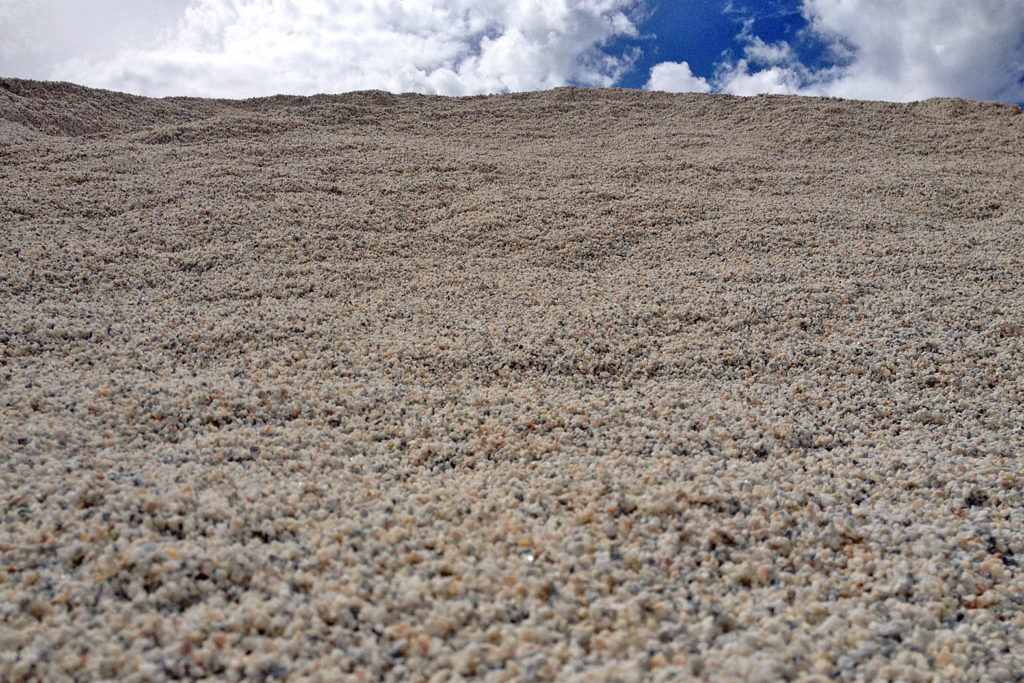
The site is mostly rock the field crew was told to limit their work to areas of interest. On this job, an aerial topo was blended with a field run topo. Here is a look at a real project for contractor’s haul road & storage in the hills near us. This procedure doesn’t always work out great, but it is an option that is fast and easy enough to try before resorting to time consuming remedies. This workaround will work best when the surfaces are close together & results will get worse as the surfaces get farther apart. Try adjusting the offset distance for the transition for larger areas or problem surfaces. Try not to let surface breaks from walls, buildings, etc lie in the transition area. Note that the offset distance I used of 5 feet may not be enough for a smooth transition. This just a quick fix when the surfaces don’t line up perfectly enough for a good paste. This is by no means a perfect solution to all pasting issues. The results are shown in the next image where the composite (green) contours now follow the EG & FG contours. This creates a 5’ transition between the two surfaces to help blend the contours better. I assigned to this new breakline elevations from the EG surface and then added it to the FG surface as a breakline. In the next image I have offset the magenta breakline by 5 feet. So what can be done besides joining contours by hand? One quick fix is to simply add one more breakline to the FG surface that lies on the EG surface. Civil 3D is trying to triangulate the composite surface at two z points all along the magenta breakline. This device is called a Stewart platform or the Gough. I followed the instructions selected Blend, clicked on the first surface, pressed enter, clicked on the second surface, and enter again. In order to do this, we are instructed to use the Blend tool. Perhaps, the best known parallel manipulator is formed from six linear actuators that support a movable base for devices such as flight simulators. For the roof, I need to blend the surfaces shown on the screenshot together to create a solid object.
BLEND EDGES OF SURFACES MILLUMIN SERIAL
This is not surprising since the breakline is a foot above the EG. A parallel manipulator is a mechanical system that uses several computer-controlled serial chains to support a single platform, or end-effector. Note how the composite contours in green now diverge from the gray EG contour. A perfect paste.īut what happens if the magenta breakline does not lie on the EG surface? Well let’s raise the magenta feature line by a foot and take a look. Note how the composite surface contours hit the magenta breakline & immediately flow into the pit. The EG is gray, FG is tan & the composite surface is in green dashes. If the magenta border for this pit lies on the EG surface, the paste will be perfect. This is not a flaw just simply how things will triangulate when points that should be coincident are not. Pasting surfaces can produce jagged contours when the border of the surface to be pasted into another does not lie on the other surface. We have seen these situations and have used a quick little procedure to help us blend surfaces when the pasting seems flawed. Perhaps when pasting small sub surfaces together the grades along the two surfaces don’t line up and need a transition. Perhaps there is a property that is too steep or densely forested to field survey & when you paste the field run surface into an the aerial surface the contours look a bit funny along the edge of the field run surface. You have field run topographic data for the channel but you need to blend the outer banks with GIS data.

Additional options include specifying a default layer for all content played within a playlist ensuring that content made for a specific screen is never played anywhere else.Have you ever pasted a couple of surfaces together & see results that you would rather not have seen? After seeing a couple of posts on the Civil 3D newsgroup and receiving a call from a friend who also had trouble pasting surfaces & was about to manually splice/join contours, I decided to blog a little bit about the topic. Because the target sets that you build are global throughout the application, you can easily change target sets on any given layer at any time and save this mapping as part of the cue so content always plays exactly the way you want it. This allows for fine-tuned design of content across rotated screens, screens of various shapes, and odd aspect ratios.
BLEND EDGES OF SURFACES MILLUMIN FULL
The media triggered in any layer can be mapped to one or more screens… either full screen or within one or more targets (rectangle, polygon, circle, bezier path). That means you can connect as many displays as your computer can handle, including graphics-direct (DVI, HDMI, VGA), broadcast (SDI), network-based (NDI, Syphon) outputs, or any combination therein. PVP3 is a multi-screen, multi-layer video playback and processing tool.


 0 kommentar(er)
0 kommentar(er)
